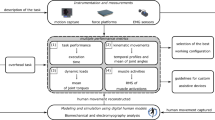Abstract
Dynamic situations are not fully controlled and affected by uncertain human factors. Anthropometric considerations are important in the design of systems. Present research work have considered the ‘angle of abduction’, whose effect on operator’s performance has been ergonomically evaluated in a CNC-EDM environment. In this work, the experimental data are analyzed through an ANOVA using SPSS statistical software. The result indicates that the angle of abduction significantly affects the operator’s performance in a CNC-EDM interaction environment. Further analysis revealed that a 45 degree abduction angle gives the optimal performance as far as a human–machine interaction environment is concerned.




Similar content being viewed by others
Explore related subjects
Discover the latest articles and news from researchers in related subjects, suggested using machine learning.References
Bendix T, Krohn L, Jessen F, Aaras A (1985) Trunk posture and trapezius muscle load while working in standing, supported-standing, and sitting positions. Spine 10(5):433–439
Choudhury MD, Dewangan KN, Prasanna Kumar GV, Suja PL (2005) Anthropometric dimensions of farm youth of the north eastern region of India. Int J Ind Ergon 35(11):979–989
Dennerlein JT, Johnson PW (2006) Changes in upper extremity biomechanics across different mouse positions in a computer workstation. Ergonomics 49:1456–1469
Fine LJ, Punnett L, Keyserling WM, Herrin GD, Chaffin DB (2000) Shoulder disorders and postural stress in automobile assembly work. Scand J Work Environ Health 26(4):283–291
Hargens AR, Jensen B, Karen (2003) Intramuscular pressure and EMG relate during static concentrations but dissociate with movement and fatigue. J Physiol 10:1–31
Hsiao H, Long D, Synder K (2002) Anthropometric differences among occupational groups. Ergonomics 45(2):136–152
Johnson PW, Dennerlein JT (2006) Different computer tasks affect the exposure of the upper extremity to biomechanical risk factors. Ergonomics 49:45–61
Kim J-Y, Chung M-K, Park J-S (2003) Measurement of physical work capacity during arm and shoulder lifting at various shoulder flexion and ad/abduction angles. Hum Factors Ergon Manuf 13:153–163
Koh D, Ong CN, Phoon WO, Low A (1988) Anthropometrics and display station preferences of VDU operators. Ergonomics 31(3):337–347
Lee YG, Yun MH, Eoh HJ, Lim SH (2001) Results of a survey on the awareness and severity assessment of the upper-limb work-related musculoskeletal disorders among the female bank tellers in Korea. Int J Ind Ergon 27:347–357
Lehman KR, Psihogios JP, Meulenbroek RGJ (2001) Effects of sitting versus standing and scanner type on cashiers. Ergonomics 44:719–738
Mohammad YAA (2005) Anthropometric characteristics of the hand based on laterality and sex among Jordanian. Int J Ind Ergon 35(8):747–754
Murphey SL, Milkowski A (2006) Surface EMG evaluation of sonographer scanning postures. J Diagn Med Sonogr 22:298–305
Smith WD, Berquer R, Davis S (2002) An ergonomic study of the optimum operating table height for laparoscopic surgery. Surg Endosc 16:416–421
Westgaard RH, Aaras A, Stranden E (1988) Postural angles as an indicator of postural load and muscular injury in occupational work situations. Ergonomics 31(6):915–933
Winer BJ (1971) Statistical principles in experimental design, 2nd edn. Mc Graw-Hill Kogakusha Ltd, Tokyo
Acknowledgments
The authors would like to acknowledge the support provided by the national small industries corporation (NSIC), a government of India undertaking, Aligarh, India.
Author information
Authors and Affiliations
Corresponding author
Additional information
Relevance for ergonomics practice: The finding of this work can be directly applied to the practical field which will improve the design of a CNC-EDM system. The study will help to reduce the musculoskeletal and other related injuries in human beings.
Rights and permissions
About this article
Cite this article
Khan, I.A., Asghar, M. Ergonomic evaluation of the angle of abduction in a computer numerically controlled electro discharge machine environment. Cogn Tech Work 12, 263–269 (2010). https://doi.org/10.1007/s10111-010-0137-4
Received:
Accepted:
Published:
Issue Date:
DOI: https://doi.org/10.1007/s10111-010-0137-4




